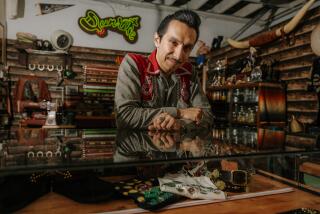A national treasure’s sterling trajectory
- Share via
TAXCO DE ALARCON, MEXICO — Metallurgically speaking, it sounds paradoxical to talk about a “Golden Age” of silversmithing. But the phrase comes naturally to Antonio Pineda as he recollects the era when his lustrous creations adorned heiresses’ throats, commanded praise from heads of state and draped the creamy skin of Hollywood stars.
Back in the day, circa 1940-80, Pineda was a charismatic, compact bundle of energy with a matinee idol’s pencil mustache and a studio mogul’s vaulting ambition. A master of silver design and sculpting, he oversaw a taller (workshop) that at its peak employed dozens of other silversmiths in relentlessly inventive activity. Fusing centuries-old techniques with the innovative tropes of Mexican Modernism, Pineda’s studio and a handful of others coined a style of high-end fashion jewelry that briefly made this remote, colonial-era town of 50,000 into a tourist lodestone.
Today, at 89, he’s a bit frailer and slower-moving. He no longer spends countless hours laboring over sleek silver necklaces with inset ovals and amethysts worthy of an Aztec princess or chic, futuristic geometric flatware fit for a millionaire’s dining table.
But his playful humor, aesthetic judgment and apostolic faith in his chosen medium remain unvarnished by time. “The richness of silver is immortal. It doesn’t die,” Pineda says, repeating a favorite maxim over a lunch of chiles rellenos with one of his former apprentices, Javier Ruiz Ocampo, at Pineda’s ranch home here.
The enduring beauty and ingenuity of Pineda’s work have inspired a large retrospective, “Silver Seduction: The Art of Mexican Modernist Antonio Pineda,” running through March 15 at UCLA’s Fowler Museum. Drawn from the collection of Cindy Tietze and Stuart Hodosh of Los Angeles, “Silver Seduction” not only aims to make tangible Pineda’s talent but also to animate the culturally rich, intense decades of Mexican history following the revolution of 1910-20.
That dynamic era of ideological and artistic ferment gave rise to Mexican Modernism and its cousin, a conspicuously 20th century brand of Mexican nationalism. The twin impulses flowered in the murals of Jose Clemente Orozco, Diego Rivera and David Alfaro Siqueiros; flowed through the introspective fiction of Juan Rulfo; haunted the iconoclastic cinematography of Gabriel Figueroa; and echoed in the primordial rhythms of composer Silvestre Revueltas.
Modernity’s spirit also took flight in the works of Taxco-based silversmiths including Pineda, Antonio Castillo, Hector Aguilar and dozens of master smiths whom they trained and/or employed in their workshops. Constantly sketching out new ideas, enamored of solving technical problems and testing rare methods, Pineda found a vocation to match his restless nature. “People always ask enthusiastically about the knowledge, the art in action, of working with silver,” he says. “I believe that art is magic; it’s cosmic.”
Another favorite aphorism from an incorrigible romantic: Silver, says Pineda, is “like a woman, because it’s white, it’s ductile, it’s an invitation to be touched, to be modeled, to be made immortal by the artist.”
Although silver had been mined in the mineral-rich Taxco region since the conquistadors arrived in the 1500s, silversmithing was minimal before the 1930s.
The godfather of Taxco’s emergence as a center of silver production was William Spratling, a U.S.-born designer-entrepreneur and Tulane University architecture professor. After moving to Mexico in the late 1920s, Spratling bought a house and set up a taller in Taxco, employing two goldsmiths from the neighboring town of Iguala. Pineda went to apprentice with him at age 11.
“We give credit to Spratling that it was he who started with a workshop,” Pineda says.
But Pineda and his colleagues in the nascent Taxco School, which included his brother Bruno Pineda, soon began to develop their own signatures, says Betsy Quick, the Fowler’s director of education and the show’s in-house curator. Moving beyond the Art Nouveau styles popular in the 1920s and ‘30s, the young silversmiths wrested and transformed ideas from a variety of sources, from the whimsical figures in pre-Columbian codices to the stark, streamlined silhouettes of Art Deco. In quintessential Modernist fashion, they emphasized surprising convergences between antique and contemporary styles.
“It seems to me that [Pineda] became very aware of a bigger world of design,” Quick says, “and then it seems to me he got on a roll of making these very bold statements.”
--
Marks of distinction
With its alloys of whimsy and sensuality, Pineda’s mature work shares certain formal properties with Rivera’s concupiscent canna lilies or Edward Weston’s curvilinear nudes. Some of Pineda’s brooches fold silver into origami-like compositions, as if made of paper. An ax-shaped pendant from 1953 is covered with a primitive hunting scene inspired by prehistoric cave paintings in Lascaux, France. Odd-couple elements -- oxidized, darkened silver and pearls, for example -- are made to seem like natural bedfellows. A silver fish-skeleton bracelet takes a good-natured Pop Art poke at elite couture.
“Over time, it becomes more and more sculptural,” Quick says of Pineda’s work. “It becomes bolder and the lines become simpler.” The constants, she adds, are beautiful, virtuous craftsmanship and the way the jewelry conforms to the individual wearer. “You put it on and it’s smooth. It really seems to fit your body.”
Pineda opened his own taller in 1939, and it didn’t take long for his genius to be recognized. The scion of Gump’s department store of San Francisco took a shine to Pineda’s work and purchased his entire collection. His jewelry was included in a 1944 exhibition in San Francisco.
Lured by the town’s antiquarian charms and the Taxco School’s rapid growth, a binational intelligentsia of writers, artists, collectors and, inevitably, Hollywood film stars began vacationing here. In the 1940s and ‘50s, the list of famous visitors was lengthy: Siqueiros, Rivera, Frida Kahlo, Sergei Eisenstein, Juan O’Gorman, Leonora Carrington, Hart Crane, William Faulkner, Marilyn Monroe, Bette Davis, Rita Hayworth, John Huston, Lyndon Johnson and dozens more. The picturesque region’s backdrop framed several feature films, including “The Fugitive” and “Second Chance.”
Some 150 silver shops were operating in Taxco in the early 1950s, and Pineda was keeping company with U.S. heiresses on lavish jewelry-shopping sprees. He has a ready-made stash of stories from those days, like the time that the great Mexican actor-director Emilio “Indio” Fernandez smashed his fist through a glass display case to grab a gold ring from Pineda’s private collection that he wanted to give as a gift to actress Maria Felix. “El Indio” emerged with a bleeding hand for his efforts. “It was too late for me to tell him the ring was not for sale by that time!” Pineda says, with a laugh.
--
Now off the beaten track
But even as the town prospered, plans were underway that would change its course. Eager to promote the nation’s magnificent southern beaches, the Mexican government in 1955 built a highway from Mexico City to Acapulco that bypassed Taxco. Although Pineda was able to keep selling his jewelry by opening a shop in the booming Pacific beach town, Taxco’s large workshops went into decline.
“Now it’s not possible to sustain a workshop of the importance of those years,” Pineda says. “The silver that there is now is a treasure, and it’s very expensive.”
Although today’s Taxco is chockablock with small silver shops, most now cater not to Hollywood elites but to regular tourists and Mexico City day-trippers.
Occasionally, the sense of what’s gone gets to the maestro. “All my friends already have disappeared, great ones of that epoch,” Pineda says. “I’m the only one that remains here. I believe that it has been to punish me, to be here by myself!”
But no matter. Creaky though he may be, he’s looking forward to attending his show’s official L.A. opening. All his children from multiple marriages and many other family members will be there with him, including some who will be meeting one another for the first time, he says.
As this thought sinks in, he and Ocampo break into smiles. “There’s going to be a revolution!” Ocampo says with a laugh.
Thanks to Antonio Pineda, in Mexican silver, there already has been one.
--
More to Read
The biggest entertainment stories
Get our big stories about Hollywood, film, television, music, arts, culture and more right in your inbox as soon as they publish.
You may occasionally receive promotional content from the Los Angeles Times.











